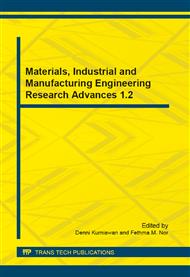[1]
D.C. Montgomery., Introduction to Statistical Quality Control., 5th Edition., John Wiley & Sons, Inc, (2005).
Google Scholar
[2]
B. Ozcelik, E. Kuram, M. M Topal, Investigation the effects of obstacle geometries and injection molding parameters on weld line strength using experimental andfinite element methods in plastic injection molding, International Communications in Heat and Mass Transfer 39 (2012).
DOI: 10.1016/j.icheatmasstransfer.2011.11.012
Google Scholar
[3]
Xuan-Phuong Dang, General frameworks for optimization of plastic injection molding process parameters, Simulation Modelling Practice and Theory 41 (2014) 15–27.
DOI: 10.1016/j.simpat.2013.11.003
Google Scholar
[4]
W. C. Lo, K. M. Tsai , C. Y. Hsieh, Six Sigma approach to improve surface precision of optical lenses in the injection-molding process, Int J Adv Manuf Technol (2009) 41: 885–896.
DOI: 10.1007/s00170-008-1543-0
Google Scholar
[5]
Chao-Ton Su, Chia-Jen Chou , A systematic methodology for the creation of Six Sigma projects: A case study of semiconductor foundry Expert Systems with Applications 34 (2008) 2693–2703.
DOI: 10.1016/j.eswa.2007.05.014
Google Scholar
[6]
A.K. Sahooa, M.K. Tiwarib, A.R. Mileham, Six Sigma based approach to optimize radial forging operation variables, journal of materials processing technology 2 0 2 (2008)125–136.
DOI: 10.1016/j.jmatprotec.2007.08.085
Google Scholar
[7]
T. Pyzdek, P. Keller , The Six Sigma Handbook, Third Edition, McGraw Hill Professional, Sep 21, (2009).
Google Scholar
[8]
D. Valles, J. Sanchez , S. Noriega , B.G. Nuñez, Implementation of Six Sigma in a Manufacturing Process: A Case Study, Implementation of Six Sigma in a Manufacturing Process: A Case Study , International Journal of Industrial Engineering, 16(3), 171-181, (2009).
DOI: 10.1504/ijssca.2021.10040699
Google Scholar
[9]
Subramanian, M. Natamai, Basics of Troubleshooting in Plastics Processing : An Introductory Practical Guide John Wiley & Sons, Inc, (2005).
Google Scholar
[10]
D.M. Levine, Statistics for six sigma green belts with minitab & JMP, Pearson (2006).
Google Scholar
[11]
Jeroen de Mast, J. Lokkerbol An analysis of the Six Sigma DMAIC method from the perspective of problem solving Int. J. Production Economics 139 (2012) 604–614.
DOI: 10.1016/j.ijpe.2012.05.035
Google Scholar
[12]
V. Arumuga, J. Antony, M. Kumar , Linking learning and knowledge creation to project success in Six Sigma projects: An empirical investigation Int. J. Production Economics 141 (2013) 388–402.
DOI: 10.1016/j.ijpe.2012.09.003
Google Scholar


